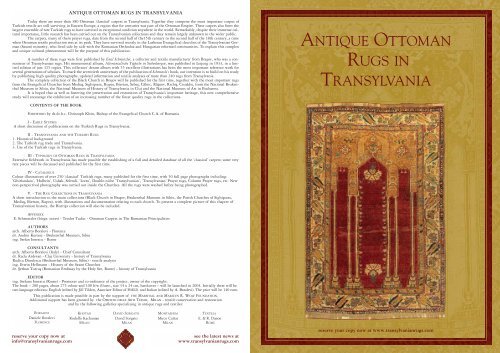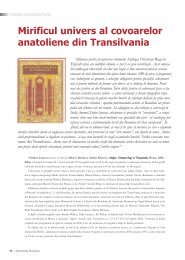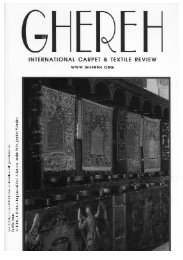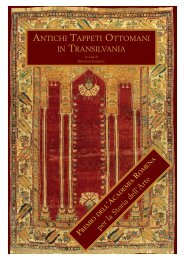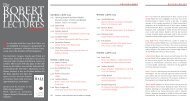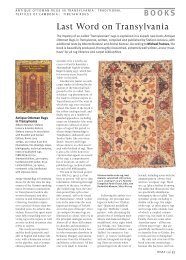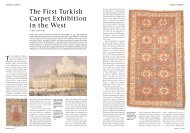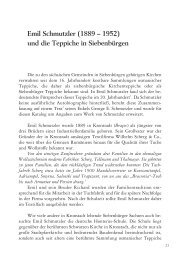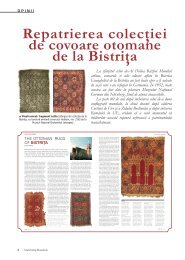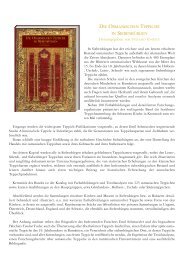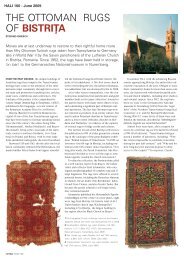Brochure HALI FAIR - Antique Ottoman Rugs in Transylvania
Brochure HALI FAIR - Antique Ottoman Rugs in Transylvania
Brochure HALI FAIR - Antique Ottoman Rugs in Transylvania
Create successful ePaper yourself
Turn your PDF publications into a flip-book with our unique Google optimized e-Paper software.
ANTIQUE OTTOMAN RUGS IN TRANSYLVANIA<br />
Today there are more than 380 <strong>Ottoman</strong> ‘classical’ carpets <strong>in</strong> <strong>Transylvania</strong>. Together they comprise the most important corpus of<br />
Turkish textile art still surviv<strong>in</strong>g <strong>in</strong> Eastern Europe, a region that for centuries was part of the <strong>Ottoman</strong> Empire. These carpets also form the<br />
largest ensemble of rare Turkish rugs to have survived <strong>in</strong> exceptional condition anywhere <strong>in</strong> the world. Remarkably, despite their immense cultural<br />
importance, little research has been carried out on the <strong>Transylvania</strong>n collections and they rema<strong>in</strong> largely unknown to the wider public.<br />
The carpets, many of them prayer rugs, date from the second half of the15th century to the second half of the 18th century, a time<br />
when <strong>Ottoman</strong> textile production was at its peak. They have survived mostly <strong>in</strong> the Lutheran Evangelical churches of the <strong>Transylvania</strong>n German<br />
(Saxon) m<strong>in</strong>ority, who lived side by side with the Romanian Orthodox and Hungarian reformed communities. To expla<strong>in</strong> this complex<br />
and unique cultural phenomenon will be the purpose of this publication.<br />
A number of these rugs were first published by Emil Schmutzler, a collector and textile manufacturer from Braãov, who was a connoisseur<br />
of <strong>Transylvania</strong>n rugs. His monumental album, Altorientalische Teppiche <strong>in</strong> Siebenburgen, was published <strong>in</strong> Leipzig <strong>in</strong> 1933, <strong>in</strong> a limited<br />
edition of just 325 copies. This collectors’ dream album with 55 excellent illustrations has been the most important reference work for<br />
several generations of scholars. To mark the seventieth anniversary of the publication of Schmutzle’s book, our <strong>in</strong>tention is to build on his study<br />
by publish<strong>in</strong>g high quality photographs, updated <strong>in</strong>formation and textile analyses of more than 240 rugs from <strong>Transylvania</strong>.<br />
The complete collection of the Black Church <strong>in</strong> Braãov will be published for the first time, together with the most important rugs<br />
from the Evangelical Churches from Mediaã, Sighiãoara, Rupea, Biertan, Sebeã, Câlnic, Râãnov, Richiã, Cisnådie, from the National Brukenthal<br />
Museum <strong>in</strong> Sibiu, the National Museum of History of <strong>Transylvania</strong> <strong>in</strong> Cluj and the National Museum of Art <strong>in</strong> Bucharest.<br />
It is hoped that as well as foster<strong>in</strong>g the preservation and restoration of <strong>Transylvania</strong>’s important heritage, this new comprehensive<br />
study will encourage the exhibition of an <strong>in</strong>creas<strong>in</strong>g number of the f<strong>in</strong>est quality rugs <strong>in</strong> the collections.<br />
CONTENTS OF THE BOOK<br />
FOREWORD by dr.dr.h.c. Christoph Kle<strong>in</strong>, Bishop of the Evangelical Church C.A. of Romania<br />
I - EARLY STUDIES<br />
A short discussion of publications on the Turkish <strong>Rugs</strong> <strong>in</strong> <strong>Transylvania</strong>.<br />
II - TRANSYLVANIA AND THE TURKISH RUGS<br />
1. Historical background<br />
2. The Turkish rug trade and <strong>Transylvania</strong>.<br />
3. Use of the Turkish rugs <strong>in</strong> <strong>Transylvania</strong>.<br />
III - TYPOLOGY OF OTTOMAN RUGS IN TRANSYLVANIA<br />
Extensive fieldwork <strong>in</strong> <strong>Transylvania</strong> has made possible the establish<strong>in</strong>g of a full and detailed database of all the ‘classical’ carpets; some very<br />
rare pieces will be discussed and published for the first time.<br />
IV - CATALOGUE<br />
Colour illustrations of over 250 ‘classical’ Turkish rugs, many published for the first time, with 50 full page photographs <strong>in</strong>clud<strong>in</strong>g:<br />
‘Ghirlandaio’, ‘Holbe<strong>in</strong>’, Ushak, Selendi, ‘Lotto’, Double-niche ‘<strong>Transylvania</strong>n’, ‘<strong>Transylvania</strong>n’ Prayer rugs, Column Prayer rugs, etc. New<br />
non-perspectival photography was carried out <strong>in</strong>side the Churches. All the rugs were washed before be<strong>in</strong>g photographed.<br />
V. - THE RUG COLLECTIONS IN TRANSYLVANIA<br />
A short <strong>in</strong>troduction to the ma<strong>in</strong> collections (Black Church <strong>in</strong> Braãov, Brukenthal Museum <strong>in</strong> Sibiu, the Parish Churches of Sighiãoara,<br />
Mediaã, Biertan, Rupea), with illustrations and documentation relat<strong>in</strong>g to each church. To present a complete picture of this chapter of<br />
<strong>Transylvania</strong>n history, the Bistri†a collection will also be <strong>in</strong>cluded.<br />
APPENDIX<br />
E. Schmutzler (biogr. notes) - Teodor Tuduc - <strong>Ottoman</strong> Carpets <strong>in</strong> The Romanian Pr<strong>in</strong>cipalities<br />
AUTHORS<br />
arch. Alberto Boralevi - Florence<br />
dr. Andrei Kertesz - Brukenthal Museum, Sibiu<br />
<strong>in</strong>g. Stefan Ionescu - Rome<br />
CONSULTANTS:<br />
arch. Alberto Boralevi (Italy) - Chief Consultant<br />
dr. Radu Ardevan - Cluj University - history of <strong>Transylvania</strong><br />
Rodica D<strong>in</strong>ulescu (Brukenthal Museum, Sibiu) - textile analysis<br />
<strong>in</strong>g. Erw<strong>in</strong> Hellmann - History of the Saxon Churches<br />
dr. Ãerban Turcuã (Romanian Embassy by the Holy See, Rome) - history of <strong>Transylvania</strong><br />
EDITOR<br />
<strong>in</strong>g. Stefano Ionescu (Rome) - Promoter and co-ord<strong>in</strong>ator of the project, owner of the copyright.<br />
The book – 200 pages, about 275 colour and 100 b/w illustr., size 34 x 24 cm, hardcover – will be launched <strong>in</strong> 2004. Initially there will be<br />
two language editions: English (edited by Jill Tilden, Associate Editor of <strong>HALI</strong>) and Italian (edited by A. Boralevi). The price will be 140 euro.<br />
This publication is made possible <strong>in</strong> part by the support of THE MARSHALL AND MARILYN R. WOLF FOUNDATION.<br />
Additional support has been granted by the OPIFICIO DELLE ARTI TESSILI, MILAN - textile conservation and restoration<br />
and by the follow<strong>in</strong>g galleries specializ<strong>in</strong>g <strong>in</strong> antique rugs and textiles:<br />
BORALEVI<br />
Daniele Boralevi<br />
FLORENCE<br />
reserve your copy now at<br />
<strong>in</strong>fo@transylvanianrugs.com<br />
KHOTAN<br />
Rodolfo Kachanian<br />
MILAN<br />
DAVID SORGATO<br />
David Sorgato<br />
MILAN<br />
MOHTASHEM<br />
Mirco Cattai<br />
MILAN<br />
TEXTILIA<br />
E. & R. Danon<br />
ROME<br />
see the latest news at<br />
www.transylvanianrugs.com<br />
ANTIQUE OTTOMAN<br />
RUGS IN<br />
TRANSYLVANIA<br />
reserve your copy now at www.transylvanianrugs.com
CAT. 1 - ‘Ghirlandaio’ rug - West Anatolia<br />
second half 15th century - 130 x 187 cm, 840 kn/dm 2<br />
This remarkable rug, published by Schmutzler and thus long familiar to all scholars and rug lovers, has never been <strong>in</strong>cluded <strong>in</strong> discussions<br />
of the ‘Ghirlandaio’ group, be<strong>in</strong>g certa<strong>in</strong>ly the oldest and perhaps the only truly conv<strong>in</strong>c<strong>in</strong>g example of the type.<br />
This is the oldest of all the rugs from <strong>Transylvania</strong>.The yellow ground is the same as that <strong>in</strong> the ‘dragon and phoenix’ rug from Berl<strong>in</strong> ,<br />
while the m<strong>in</strong>or ‘S’ cha<strong>in</strong> is identical to that of the ‘Marby’ and occurs <strong>in</strong> other rare 15th century examples, such as the ‘Cagan’ animal rug,<br />
found <strong>in</strong> Tibet <strong>in</strong> the 1980s and now <strong>in</strong> the collections of the Metropolitan Museum <strong>in</strong> New York. - Schmutzler 1933, plate 8<br />
EVANGELICAL CHURCH HÅLCHIU - HELDSDORF - <strong>in</strong>v. III 23**<br />
CAT. 18 - ‘Lotto’ - early 17th cent. - 144 x 164 cm<br />
‘Anatolian’ style field and ragged palmette border.<br />
Csányi 1914, cat. 6 - Végh e Layer 1925, table 3<br />
Schmutzler 1933, plate 16<br />
EVANGELICAL CHURCH HÅRMAN - <strong>in</strong>v. 273<br />
CAT. 119 - Double niche ‘<strong>Transylvania</strong>n’<br />
second half 17th cent. - 122 x 170 cm, 1224 kn/dm 2<br />
donor <strong>in</strong>scription: H ANNES M ERGLERS G ABE ZUR<br />
W EIDENB. KIRCHE 1706<br />
EVANGELICAL CHURCH GHIMBAV - <strong>in</strong>v. III 15**<br />
A few examples of the 250 rugs illustrated <strong>in</strong> colour <strong>in</strong> the book.<br />
CAT. 57 - ‘Bird’ Ushak - first half 17th cent. - 137 x 204 cm<br />
The earliest <strong>in</strong>scription on a rug <strong>in</strong> <strong>Transylvania</strong>:<br />
TESTAMENTVM LAVRENTIVS BOLKESCH AD 1646<br />
Schmutzler 1933, plate 3<br />
THE MONASTERY CHURCH, SIGHIÃOARA - SCHÄßBURG - <strong>in</strong>v. 534<br />
CAT. 160 - ‘<strong>Transylvania</strong>n’ prayer rug<br />
first half 17th cent. - 132 x 175 cm, 1332 kn/dm 2<br />
donor <strong>in</strong>scription: 1720 D. MAYS<br />
BRUKENTHAL MUSEUM, SIBIU - <strong>in</strong>v. M. 1618


